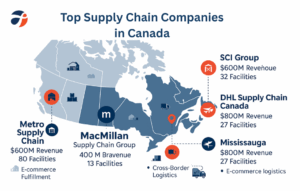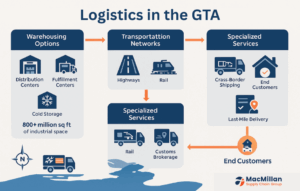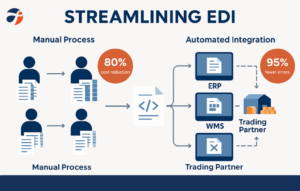Growing tariffs, geopolitical unrest, and changing manufacturing environments present the electronics supply chain with previously unheard-of difficulties. This thorough guide examines the ways in which digital transformation, tariff mitigation, and strategic reshoring can help Canadian companies manage these challenges. Specialized 3PL solutions are provided by MacMillan Supply Chain Group to assist businesses in strengthening their supply chains, cutting expenses, and increasing resilience. Learn useful strategies to prosper in the face of trade disruptions and set up your company for long-term success in Canada’s developing electronics industry, from utilizing foreign trade zones to putting blockchain traceability into place. This guide will help Canadian companies future-proof their electronics supply chain.
The Changing Landscape of Electronics Manufacturing
The electronics manufacturing industry is changing dramatically. Major economy-to-economy tariffs have risen to all-time highs, with some electronic components subject to 245% duties. Global supply chains have been rocked by this, and businesses are now being forced to reconsider where and how they manufacture their products.
These issues offer opportunities as well as challenges to Canadian companies. Effectively managing tariffs has emerged as a crucial business ability, and reshoring in Canada presents a viable substitute for manufacturing that is done abroad. More flexibility, transparency, and resilience are now more important than ever in the electronic supply chain.
Numerous Canadian electronics manufacturers have benefited from our assistance at MacMillan Supply Chain Group in adjusting to these shifting circumstances. In today’s intricate trading environment, our specialized 3PL services offer the infrastructure and know-how required to overcome supply chain interruptions and preserve competitive advantage.
Understanding Tariff Impacts on Canadian Electronics
For Canadian electronics companies, tariffs have become a major headache. Canadian companies are frequently caught in the crossfire of trade disputes between the United States and China. Before a Chinese-made component reaches its final destination in North America, it may be subject to several tariffs, which would significantly raise supply chain costs.
Think about the effects of tariffs on semiconductors, which are the fundamental components of contemporary electronics. Everything from smartphones to medical devices is impacted when these tiny chips are subjected to 50% or more of the workload. Higher production costs, reduced margins, and challenging pricing decisions are what this means for Canadian manufacturers.
Strategies for mitigating tariffs are now crucial business tools. Smart businesses are looking into possibilities such as:
Strategic inventory control (purchasing prior to the imposition of tariffs)
Replacement of components with non-tariffed substitutes
Moving assembly to areas that comply with the USMCA
Utilizing the benefits of foreign trade zones to postpone duty payments
Through specialized logistics planning, MacMillan assists Canadian companies in putting these strategies into practice. Our customs compliance specialists examine tariff codes, spot areas for improvement, and create customized solutions that reduce duty exposure while preserving supply chain effectiveness.
 Reshoring: Relocating Electronics Production to Canada
Reshoring: Relocating Electronics Production to Canada
As companies reevaluate their global manufacturing strategies, the idea of reshoring in Canada has gained a lot of traction. While tariffs reduced the economic appeal of offshore production, the pandemic revealed weaknesses in extended supply chains. Many electronics manufacturers are moving their manufacturing closer to home these days.
This change has been largely attributed to Canadian manufacturing incentives. Companies that invest in domestic production can receive grants, tax breaks, and other forms of assistance from federal and provincial programs. By creating more robust supply networks, these incentives aid in offsetting the higher labor costs connected to North American manufacturing.
Reshoring has advantages beyond just the bottom line:
Shorter lead times and lower transportation expenses
Improved quality assurance and protection of intellectual property
Easier adherence to North American trade laws
Reduced shipping distances result in a smaller carbon footprint
Increased responsiveness and visibility in the supply chain
At MacMillan, we provide specialized warehousing, distribution, and logistics services to support reshoring initiatives. Our well-positioned facilities across Canada give businesses the framework they need to successfully execute reshoring plans, and our cross-border knowledge guarantees seamless integration with American markets.
Digital Transformation in the Canadian Electronics Supply Chain
Canadian businesses in the electronics supply chain are turning to digital platforms the way electronic supply chains function is being revolutionized by technology. Businesses can now confidently navigate complex trade environments thanks to AI-driven supply chain solutions, which offer previously unheard-of visibility and control.
Among the most potent uses of this technology are BOM optimization tools. Before production starts, these systems find cost-saving options by comparing bills of materials to tariff databases. Manufacturers can incorporate tariff mitigation into their product designs from the outset by choosing components according to origin, classification, and duty exposure.
Another significant benefit is blockchain traceability. Immutable records of a component’s movement through the supply chain are produced by this technology, offering:
Verifiable proof of origin for customs declarations
Defense against the supply of fake parts
Automated documentation for regulatory compliance
Visibility in real time over intricate multi-tier networks
MacMillan helps customers use technology to gain a competitive edge by incorporating these digital capabilities into our logistics services. Our systems offer real-time data flows that facilitate improved decision-making across the supply chain by integrating seamlessly with manufacturer ERPs.
Regional Alternatives and Trade Agreements
Pure domestic production isn’t always possible, even though reshoring has many advantages. For this reason, a lot of Canadian electronics companies are looking into regional options that strike a balance between supply chain resilience and cost considerations.
Opportunities for nearshoring to Mexico have garnered a lot of interest. Mexico provides competitive labor rates and duty-free access to the U.S. and Canadian markets as a member of the USMCA trade zone. Mexico is now the production center for many electronics manufacturers’ “China+1” strategies in the Western Hemisphere.
Important frameworks for cross-border trade are provided by the USMCA agreement itself. Electronics manufacturers can avoid tariffs and preserve effective production networks by adhering to regional content requirements. For competitive positioning, it is essential to comprehend and take advantage of these provisions.
Beyond North America, other regional options include:
Southeast Asian countries for large-scale manufacturing, such as Vietnam and Malaysia
Eastern European locations for access to European markets
India’s expanding electronics industry, bolstered by the PLI scheme
Clients can effectively navigate these regional networks with the aid of MacMillan’s cross-border freight optimization services. Our knowledge of customs guarantees adherence to documentation specifications, rules of origin, and other trade laws that affect shipments of electronics.
Challenges in Electronic Supply Chain Management
For any modern electronics supply chain, tariff volatility has become a key threat. Notwithstanding the advantages, businesses encounter several obstacles when negotiating the current electronic supply chain environment:
Uncertainty and Tariff Volatility
Planning for the long term is challenging due to the frequent changes in trade policies. Carefully calibrated supply chains may be disrupted if a component that is duty-free today is subject to substantial tariffs tomorrow.
Complexity of Compliance
Beyond tariffs, electronics are subject to a complex web of regulations, such as those pertaining to restricted substances, environmental standards, and product safety. Significant compliance burdens result from meeting these diverse demands across several markets.
Supply Concentration Risks
Many essential components are still concentrated in particular areas despite reshoring initiatives. Battery cells, semiconductors, and display technologies frequently have few sourcing choices, making them susceptible to interruptions.
Increasing Costs of Logistics
With container rates varying greatly, transportation costs have skyrocketed. For electronics manufacturers, budget forecasting is difficult due to these erratic expenses.
Gaps in Talent and Knowledge
Many businesses lack the specific knowledge required to handle intricate trade laws. Without this information, companies risk missing out on optimization opportunities or unintentionally breaking compliance regulations.
 MacMillan’s Approach to Electronic Supply Chain Optimization
MacMillan’s Approach to Electronic Supply Chain Optimization
We at MacMillan Supply Chain Group have created all-inclusive solutions to deal with these issues in the electronic supply chain:
Strategic Tariff Navigation
Our customs compliance team offers knowledgeable advice on origin determination, valuation, and tariff classification. We assist customers in determining the best strategies for their particular products, such as:
Utilizing foreign trade zones to postpone or possibly lower duty payments
Using first sale for export tactics that could reduce the dutiable value
Opportunities for duty drawbacks for exports with previously imported components
Tariff engineering to optimize product design and classification
We have assisted electronics clients in lowering duty costs by 15–30% while still adhering to all legal requirements by methodically implementing these tariff mitigation techniques.
Reshoring Support Infrastructure
We offer the logistical foundation required for businesses looking to reshore in Canada to succeed:
Just-in-time delivery systems that lower the cost of carrying inventory
Strategic warehousing in important Canadian manufacturing hubs
Sensitive electronic components require special handling
Value-added services that link Canadian operations with U.S. markets include light assembly, packaging, and kitting
While we manage the intricate logistics that make reshoring feasible, our infrastructure allows manufacturers to concentrate on their primary production tasks.
Digital Supply Chain Integration
The technology platform from MacMillan integrates with client systems to offer improved control and visibility:
Tracking inventory in real time across several locations
Automated compliance checks and customs paperwork
Predictive analytics that foresee possible interruptions before they happen
Connecting blockchain traceability systems to improve transparency
Clients can react more swiftly to shifting market conditions, such as tariff adjustments, supply interruptions, or demand swings, thanks to these digital capabilities.
Regional Network Optimization
We assist customers in creating and overseeing regional supply networks that strike a balance between affordability, resilience, and speed:
USMCA-compliant logistics that optimize duty-free opportunities
Multi-node distribution strategies that strategically position inventory
Specialized cross-border services between Mexico, the United States, and Canada
International freight handling for parts coming from Europe or Asia
Based on their unique product needs, we assist clients in striking the ideal balance between nearshoring, reshoring, and global sourcing by streamlining these networks.
Compliance Expertise
Our specific expertise aids customers in navigating the intricate regulatory framework of the electronics trade:
Export controls and restricted party screening
Documentation for preferential trade agreements
Harmonized System (HS) classification guidelines
Electronic waste compliance with environmental regulations
Record-keeping systems that meet customs requirements
This knowledge finds opportunities for legal duty savings while averting expensive delays, fines, and supply chain interruptions.
 Acting: Putting Electronic Supply Chain Solutions into Practice
Acting: Putting Electronic Supply Chain Solutions into Practice
Here are some doable actions you can take to put effective solutions in place if your electronics company is having problems with tariffs and supply chain interruptions:
Step 1: Evaluate Tariff Vulnerabilities
Start by looking through the bill of materials for your product to find any parts that have unstable or high tariffs. Effective mitigation begins with an understanding of this exposure. Pay close attention to batteries, semiconductors, and other expensive parts that frequently receive targeted duties.
Step 2: Explore Reshoring Opportunities
Determine which parts of your production could profit from being reshored in Canada. Take into account all landed costs, including risk factors, transportation, tariffs, and inventory carrying, in addition to labor costs. Look into manufacturing incentives in Canada that could help you with your transition.
Step 3: Put Digital Tracking Systems in Place
Implement supply chain visibility technologies. Your capacity to handle interruptions and react to tariff changes can be greatly enhanced by even the most basic track-and-trace features. More sophisticated systems are able to optimize routing choices and automate compliance.
Step 4: Collaborate with Supply Chain Professionals
MacMillan Supply Chain Group can play a significant role in this situation. Our specialized 3PL services offer the infrastructure, technology, and experience required to successfully negotiate the intricate trade environment of today. We provide:
Electronics manufacturers can benefit from customized logistics solutions
Strategic warehousing across Canada with specialized handling capabilities
Customs compliance knowledge to reduce the impact of tariffs
Integration of technology that improves control and visibility
Scalable capacity that expands with your company
You can access capabilities that would be unaffordable to develop internally by collaborating with MacMillan. Our staff works as an extension of yours, offering infrastructure and specialized knowledge to help you manage tariffs and create a more robust electronic supply chain.
Get in touch with MacMillan Supply Chain Group right now to find out how our customized 3PL solutions can support the success of your electronics company in the competitive market of today. Our professionals will assess your particular requirements and create a tailored strategy to deal with your particular supply chain difficulties.
Follow us on LinkedIn for real-time tariff updates
FAQS
Recent tariffs have created cascading cost increases throughout the electronic supply chain. Components manufactured in China may face duties of 145-245% before reaching Canada, significantly increasing production costs. Canadian electronics manufacturers have experienced margin compression, supply disruptions, and pricing challenges. Many have responded by diversifying suppliers, reshoring production, or implementing tariff mitigation strategies like foreign trade zones and strategic inventory management.
The most effective strategies include: utilizing foreign trade zones to defer duty payments; implementing BOM optimization tools to identify non-tariffed component alternatives; strategic inventory management to avoid tariff implementation dates; supplier diversification across multiple countries; and leveraging USMCA provisions for duty-free treatment. The optimal approach depends on your specific products, supply chain structure, and business objectives.
Canada offers several incentives at federal and provincial levels, including: the Strategic Innovation Fund providing contributions for large projects; Scientific Research and Experimental Development (SR&ED) tax credits; provincial manufacturing and processing tax credits; regional development agency grants; and workforce development programs. These incentives can significantly offset the higher operational costs associated with Canadian manufacturing.
While the CHIPS Act primarily targets U.S. semiconductor production, its impact extends to Canadian companies in several ways. It's creating new North American semiconductor capacity that Canadian manufacturers can access with shorter lead times and reduced tariff exposure. However, it may also divert some investment from Canada to the U.S. Canadian companies in the semiconductor supply chain can potentially participate as suppliers to CHIPS Act-funded projects.
Foreign trade zones offer several benefits: duty deferral until products enter the domestic market; duty elimination on re-exported goods; duty reduction through inverted tariff relief when finished goods have lower duty rates than components; simplified customs procedures; and enhanced inventory management. These advantages can significantly reduce the cash flow impact of tariffs on electronics with global supply chains.

 Reshoring: Relocating Electronics Production to Canada
Reshoring: Relocating Electronics Production to Canada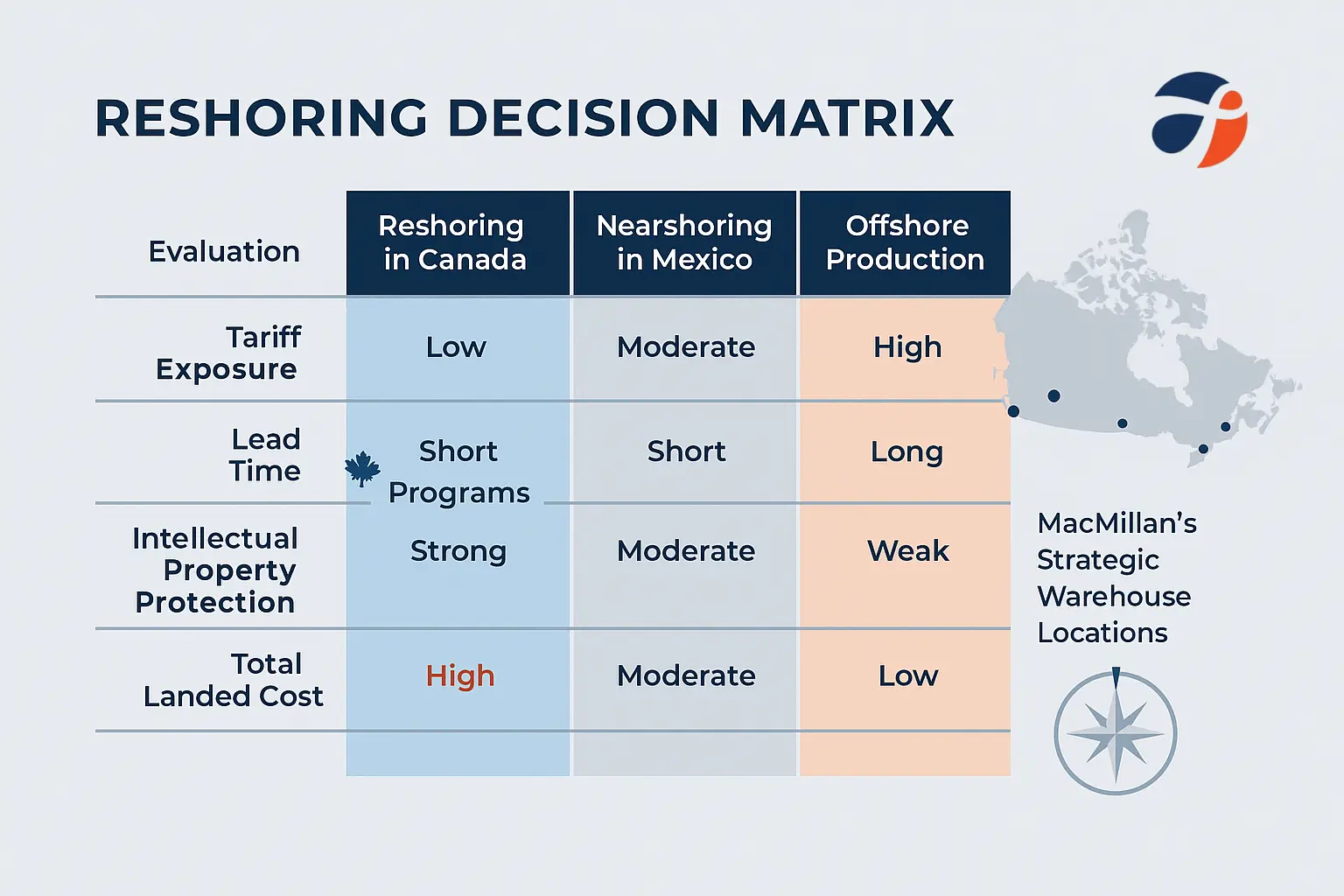 MacMillan’s Approach to Electronic Supply Chain Optimization
MacMillan’s Approach to Electronic Supply Chain Optimization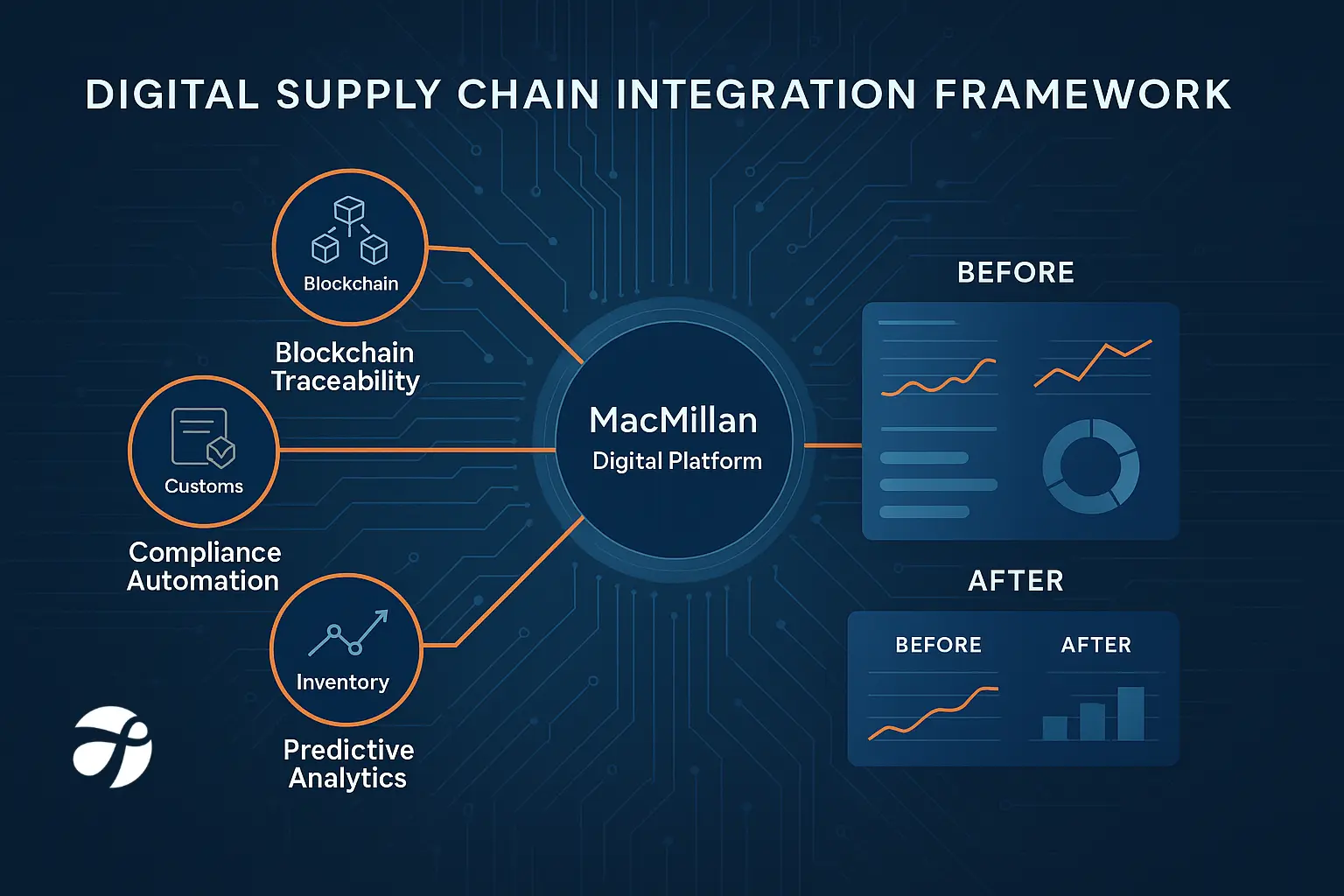 Acting: Putting Electronic Supply Chain Solutions into Practice
Acting: Putting Electronic Supply Chain Solutions into Practice